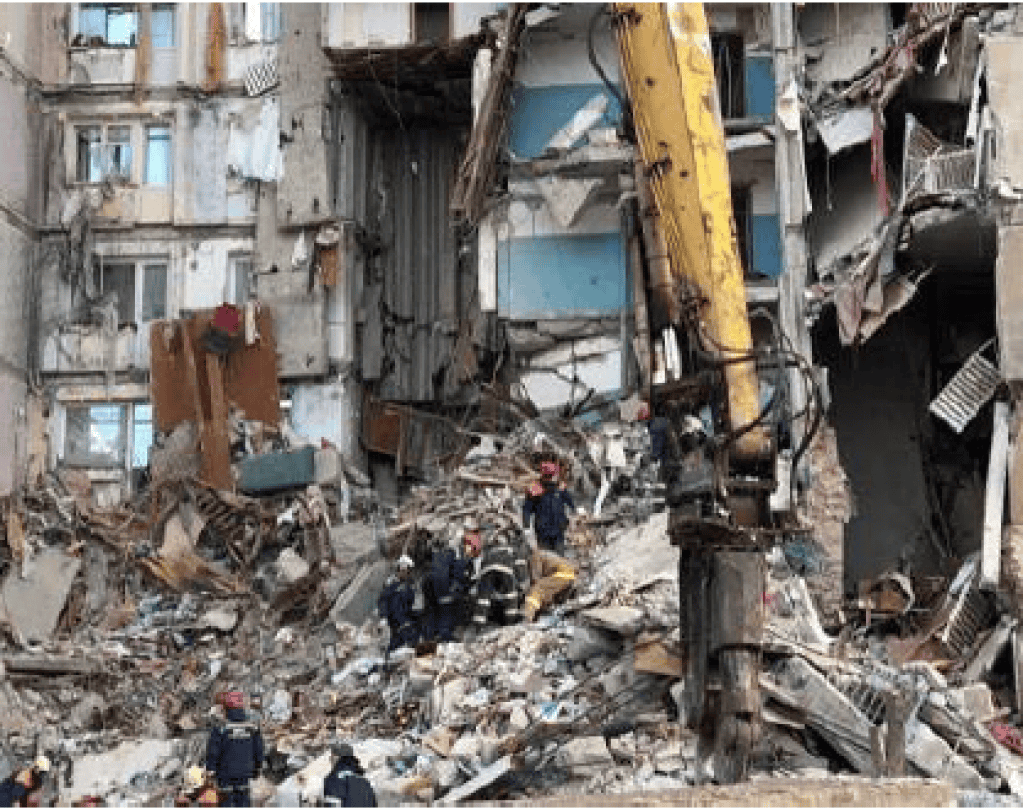
The 165th issue of the Islamic State’s An-Naba newsletter, which was released online on Jan. 17, contained a curious claim of responsibility for two supposed attacks in the Russian city of Magnitogorsk.
Over two weeks earlier, on Dec. 31, an apartment building was rocked by an explosion that leveled several floors, killing and wounding dozens of people. According to Naba’s editors, the incident was really an “operation” conducted by the Islamic State’s Caucasus province. The jihadists supposedly “detonated the explosive on the Crusaders, destroying a large part of the building.” And they didn’t announce their responsibility sooner “due to security measures.”
The Islamic State’s media team wasn’t finished. They claimed that a separate bombing on board a bus, or minivan, in Magnitogorsk the following day was also the work of their compatriots. Three people were reportedly killed on Jan. 1, when a bus burst into flames.
It is not clear if these claims are entirely made up, or if there is something to them. FDD’s Long War Journal will update this report if and when solid, independent evidence or reporting becomes available.
The Russian government did not immediately rule out a deliberate explosion at the apartment building, but claims that a gas leak is the most likely explanation for the incident. Russian state news reports say that no explosive residue has been found.
“From the very beginning, the investigation has been looking into all possible causes of the tragedy,” Svetlana Petrenko, the Russian Investigative Committee’s spokesperson, told the government news agency TASS. “A household gas explosion is still believed to be the main cause. I would like to stress that experts found no traces of explosives at the site.”
Petrenko added that “journalists” should “not trust the statements of terrorist organizations that often claim responsibility for high-profile incidents taking place in various countries.”
Thus far, the Islamic State hasn’t offered any definitive evidence connecting the apartment explosion to its network of operatives and supporters. It is often difficult, if not impossible, to verify the details of events that occur inside Russia, as the government is not always forthcoming. And there have been conflicting accounts after attacks inside Russia in the past.
For instance, on Apr. 21, 2017, the Islamic State claimed responsibility for a shooting at the local office of Russia’s Federal Security Service (FSB) in the city of Khabarovsk. The Russian government blamed a “a member of a neo-Nazi group.”
Verified recent terror plots in Russia and Chechnya
The Islamic State has claimed responsibility for other terrorist attacks in Russia, as well as the 2015 bombing of a Russian airliner that had departed from the Sinai in Egypt. That jihadists portrayed that bombing with an improvised explosive device (IED) as retaliation against Russia for its role in the Syrian war.
On Dec. 27, 2017, more than a dozen people were wounded in a bombing at a St. Petersburg market. Russian President Vladimir Putin quickly described the incident as a “terrorist attack.” Two days later, the Islamic State released a short statement claiming that its “covert unit” or detachment was responsible for placing the shrapnel-laden bomb.
Only weeks earlier, in mid-Dec. 2017, the CIA helped Russian intelligence thwart a terror network that was allegedly plotting a mass casualty attack in St. Petersburg. It isn’t clear if the Dec. 27 bombing was related to this plotting.
A separate attack occurred in St. Petersburg on Apr. 3, 2017, when an ethnic Uzbek man blew himself up on a metro train, killing fifteen people. A previously unknown group named Katibat Imam Shamil claimed responsibility for Jalilov’s suicide bombing, alleging he was dispatched “under the directives” of al Qaeda emir Ayman al-Zawahiri.
The Islamic State has claimed responsibility for other small-scale attacks in Russian territory. In some cases, the so-called caliphate has demonstrated its ties to the terrorists responsible by releasing videos of the perpetrators swearing their allegiance to Abu Bakr al-Baghdadi. This was the case after an Aug. 2016 attack on police in Balashikha, an Aug. 2017 stabbing rampage in the Russian city of Surgat, the Mar. 2018 knifings in Grozny, and an Aug. 2018 assault carried out by minors with at least one car and blades in Chechnya.
Such videos provide solid evidence of a connection, even if it is only a digital one, between the Islamic State and individual terrorists or small cells. As of yet, the Islamic State has not released any such footage from Magnitogorsk.








1 Comment
Well as sad as it is, not sure that either the Russian Govt or ISIS is to be trusted in this report. It seems too big for a gas leak explosion but a gas leak could have aided a deliberate attack. On the other hand, why would ISIS attack a poor apartment building. ISIS is done, they just don’t know it yet. Nobody really respects al Qaeda anymore- in fact, they’ve become a non-player in Yemen (al Qaeda in the Arabian Peninsula) and Da’esh has also become a nobody.